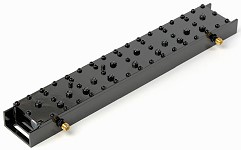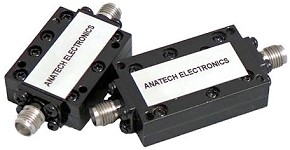|

Sam Benzacar of Anatech Electronics, an RF and microwave filter company, has published
his December 2022 newsletter that features his short op-ed entitled "The
Resurgence of Microwave Directed Energy Weapons." The premise of directed energy
(DE) weapons is to blast RF/microwave energy at a specific frequency or band of
frequencies at a high enough power to confuse or totally disable drones and/or
missiles while in flight, before reaching their intended targets. Sam argues
reasonably that the relatively low power and aiming requirements of a microwave
directed energy system can be much more effective than a high power laser beam
that must be aimed and track the target precisely enough to make surface
contact. An RF system can make multiple "shots" in the same time required for a
laser power supply to recharge between shots. A great example of how DE works
can be seen in this decade-old video of an
Active Denial System used to
disperse unruly crowds. The targets are humans, but the reactions are analogous
to how radio receivers are affected.
A Word from Sam Benzacar - The Resurgence of Microwave Directed
Energy Weapons
 By Sam Benzacar By Sam Benzacar
If you're not familiar with directed-energy (DE) weapons, you're not alone because
they've flown under the radar, so to speak, for decades. But as Russia rains drones
down in swarms throughout Ukraine, they're getting a lot more attention because
it makes little sense to shoot down a $20,000 drone with a $200,000 missile. High-power
microwave (HPM) DE weapons would go a long way toward solving this imbalance and
in many cases better than their laser-based counterparts.
First, it takes longer for a laser to fire, and the beam must reside on the target
long enough to destroy it. Next, although firing a laser costs almost nothing compared
to a missile, one laser shot (hopefully) equals one dead drone. In contrast, HPM
fires in less than a second and has a deep magazine (i.e., the ability to fire numerous
times before being rearmed or resupplied) and can simultaneously destroy or degrade
multiple targets.
Things have changed a lot since the 1960s, when the potential of non-kinetic
weapons was first realized. Back then, electronics were analog and far less susceptible
to being disabled or destroyed by a blast of microwave energy, which meant you needed
hundreds of kilowatts or even gigawatts of radiated RF power to make the kill. Today,
the control and communications systems on every aircraft are solid-state, so the
goal is not to completely fry them but confuse, disable, or destroy them, which
takes much less RF power, so DE systems can be smaller and consume less DC power.
Nevertheless, even with the gain generated by a high-gain directional antenna,
microwave DE system still require amplifiers capable of generating significant amounts
of RF power, and vacuum tube technology continues to reign supreme. However, gallium
nitride is likely to change that, and the first example is the
Leonidas DE system
near the production stage developed by Epirus in Los Angeles.
Leonidas uses an active phased array powered by GaN MMICs that, like AESA radars,
uses beam steering to focus energy on a target or targets at high speed, so it can
potentially fend off huge numbers of drones. It's small enough to be mounted on
the back of a pick-up truck and be programmed to have "no-energy zones" that keep
the beam from interrupting the operation of friendly forces and consumes less DC
power while still producing enough radiated energy to disable an adversary's electronics.
Rather than focusing the frequencies used by the aircraft (including drones)
to communicate and navigate, it delivers something more akin to an electromagnetic
pulse (EMP) that spans frequencies from near DC to hundreds of gigahertz, so the
frequencies used by the target really don't matter.
I suspect Leonidas is the trend for the future, especially with the rise of drone
warfare, in which dozens or even hundreds of drones are launched to form a swarm,
each one communicating with the others.
 Automakers Axe Am Radios Automakers Axe Am Radios
EVs from Audi, BMW, Porsche, Tesla, and Volvo haven't included AM radios for
years, BMW launched its first EVs, the i3 and i8, without AM receivers, and Tesla
originally included an AM radio in its Model S but then killed it. Even some hybrids
are abandoning the technology, such as Volvo's T8 PHEVs. Their decisions are based
on the fact that EVs generate a lot of electromagnetic interference, which would
make AM reception even worse than usual. If that was true, then you might assume
that all EVs would ditch them, which isn't the case. AM broadcasting is nearly extinct
in Europe but not in the U.S. because in rural areas it can be the only choice,
as it propagates over much longer distances than FM.
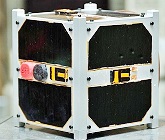 EU to Build Satcom Network EU to Build Satcom Network
The EU is about to finalize a plan to build a satellite internet service to fill
in gaps in terrestrial broadband coverage and provide "strategic independence.”
This should allow for commercial high-speed broadband availability throughout Europe,
removing dead zones and providing connectivity in remote places such as Africa and
the Arctic region. Unlike Starlink's growing constellation, the EU plans for satellites
in geostationary orbit via Eutelsat's 36 satellites and OneWeb's 428 satellites.
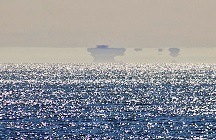 Atmospheric Ducting Helped Sink the Moskva Atmospheric Ducting Helped Sink the Moskva
When a Ukrainian navy anti-ship missile battery destroyed the Russian destroyer
Moskva in the Black Sea, questions arose about how this could be possible, as Ukraine
has no ships or aircraft in the region. The answer appears to be a temperature inversion
that resulted in atmospheric ducting that allowed radar signals to travel over the
curve of the Earth and back. This should not have been possible under normal conditions,
but the boundary layer created by a temperature inversion allowed a radar with a
range of 50 miles to see over the horizon.
 Start-up Sets Sights on Wireless Electricity Transfer Start-up Sets Sights on Wireless Electricity Transfer
Reach Power has raised $30 million in funding to help commercialize its concept
of beaming electricity wirelessly, according to Reuters. Using high-gain, narrow-beamwidth
antennas, the approach demonstrated its ability to operate a radio without batteries
from up to 25 feet from the transmitter. The start-up company has inked a deal with
the Defense Department for prototypes that combine multiple energy-beaming modules
and has also developed an IC that can transmit and receive waves carrying electricity.
Customers could include manufacturers and logistics companies.
Anatech Electronics Introduces a New Line of Suspended
Stripline and Waveguide Type RF Filters
Check out Our Filter Products
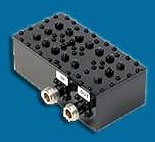
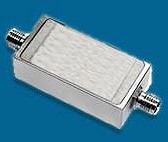

Cavity Band Pass Filters
LC Band Pass Filters Cavity Bandstop/Notch Filter
About Anatech Electronics
Anatech Electronics, Inc. (AEI) specializes in the design and manufacture of
standard and custom RF and microwave filters and other passive components and subsystems
employed in commercial, industrial, and aerospace and applications. Products are
available from an operating frequency range of 10 kHz to 30 GHz and include cavity,
ceramic, crystal, LC, and surface acoustic wave (SAW), as well as power combiners/dividers,
duplexers and diplexers, directional couplers, terminations, attenuators, circulators,
EMI filters, and lightning arrestors. The company's custom products and capabilities
are available at www.anatechelectronics.com.
Contact:
Anatech Electronics, Inc.
70 Outwater Lane
Garfield, NJ 07026
(973)
772-4242
sales@anatechelectronics.com
Posted December 22, 2022
|









 By Sam Benzacar
By Sam Benzacar Automakers Axe Am Radios
Automakers Axe Am Radios  EU to Build Satcom Network
EU to Build Satcom Network  Atmospheric Ducting Helped Sink the Moskva
Atmospheric Ducting Helped Sink the Moskva  Start-up Sets Sights on Wireless Electricity Transfer
Start-up Sets Sights on Wireless Electricity Transfer 